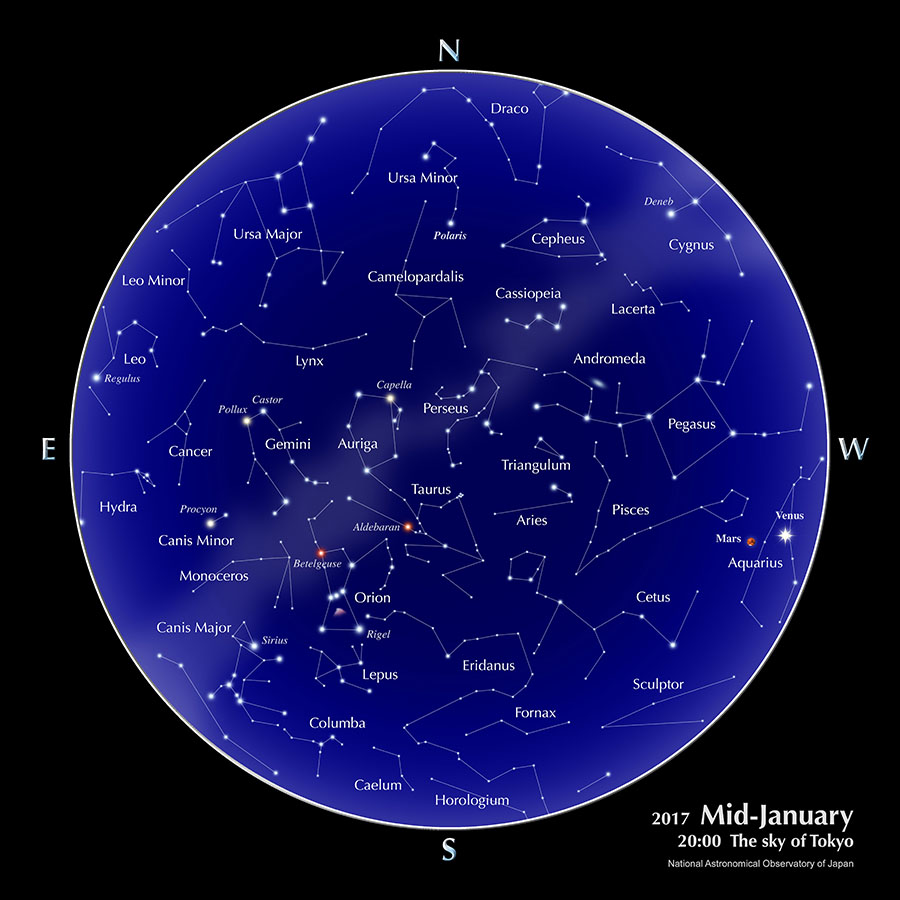The sky of Tokyo, Calendar, Planets (January, 2017)
The sky of Tokyo

Calendar (January)
| 1 | New Year’s Day [Ganjitsu] (national holiday) |
| 2 | Holiday |
| 3 | Quadrantid Meteor Shower peaks around 23:00. (For Japan, the best visibility will be before dawn on the 4th. About 35 meteors per hour are expected. Because there is no moonlight and the timing of the maximum is not so bad, conditons are relatively good.) |
| 4 | Earth passes perihelion |
| 6 | First Quarter Moon |
| 8 | Mercury at stationary point |
| 9 | Coming-of-Age Day [Seijin-no-hi] (national holiday) / Occultation of Aldebaran |
| 12 | Full Moon / Greatest Eastern Elongation of Venus |
| 19 | Greatest Western Elongation of Mercury |
| 20 | Last Quarter Moon |
| 28 | New Moon |
The days for the peak activities of the meteor showers are based on the predictions of IMO(International Meteor Organization).
Planets
- Mercury
- Mercury is positioned low in the southeastern sky just before sunrise. It reaches greatest western elongation on the 19th. From the 9th to 22nd, 30 minutes before sunrise, Mercury’s elevation as seen from Tokyo becomes higher than 10 degrees, making observations easy. From the 9th to the 22nd, its brightness is 0.4 magnitude to -0.2 magnitude.
- Venus
- Venus shines brightly low in the southwestern to western sky after sunset. It reaches greatest eastern elongation on the 12th. Its brightness is -4.3 magnitude to -4.6 magnitude.
- Mars
- In the beginning and middle of January, Mars moves from the constellation Aquarius to the constellation Pisces. It can be seen in the southwestern to western sky after sunset. It sets around 9 pm as seen from Tokyo. Its brightness is 0.9 magnitude to 1.1 magnitude.
- Jupiter
- Located in the constellation Virgo, Jupiter can be seen in the southern to southwestern sky before dawn. Its brightness is -1.9 magnitude to -2.1 magnitude.
- Saturn
- Located in the constellation Ophiuchus, Saturn is positioned low in the southeastern sky before dawn. Its elevation becomes higher in the end of January and it becomes easier to see. Its brightness is 0.5 magnitude.
Source: Ephemeris Computation Office, NAOJ
With the “Sky Viewer” you can easily explore the appearance of a typical urban night sky (planets and constellations are visible). The Celestial Phenomena section of the glossary explains the planetary phenomena terms: greatest elongation, opposition, conjunction, stationary, etc.